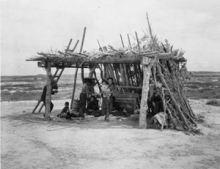Article
Also known as a brush hogan, a summer hogan is a temporary shelter typically made of three forked poles and covered with the boughs of cedar or piñon pine. These structures are generally used during summer, when it is too hot to have thick earthen-walled hogans. Summer hogans are also constructed for ceremonial use. When used for ceremonies, summer hogans are constructed with specific materials, depending on their purpose. For example, if a summer hogan is constructed for a ceremony to bring female rain, piñon branches would used, whereas for a ceremony to bring male rain, cedar would be used. Additionally, summer hogans take varied forms, depending on the use or need. If the hogan were being constructed for a ceremony, for example, and only a wind break would be needed, then the hogan might have only one wall.
"Navajo family in their summer hogan, Navajo Nation Reservation, NM, circa 1955," photograph, New Mexico Magazine Collection, Album 28 (HP.2007.20.591). Palace of the Governors Photo Archive. Use with permission only.
Manuscripts
References
Hill, W. W.
1938 The Agricultural and Hunting Methods of the Navaho Indians. New Haven:
Published for the Department of Anthropology, Yale University, by the Yale University
Press.
Jett, Stephen C. and Virginia E. Spencer
1981 Navajo Architecture: Forms, History, Distributions. Tucson: University of Arizona
Press.

